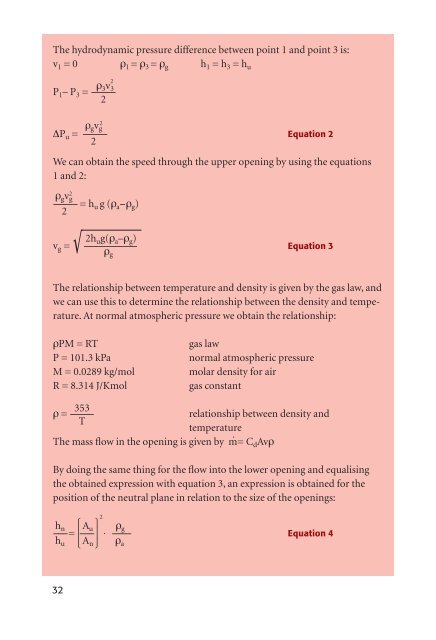Fire ventilation
Fire ventilation
Fire ventilation
Create successful ePaper yourself
Turn your PDF publications into a flip-book with our unique Google optimized e-Paper software.
The hydrodynamic pressure difference between point 1 and point 3 is:<br />
v 1 = 0 ρ 1 = ρ 3 = ρ g h 1 = h 3 = h u<br />
ρ 3v 2<br />
3<br />
P 1– P 3 = −−−−−<br />
2<br />
ρgv g 2<br />
ΔP u = −−−−− Equation 2<br />
2<br />
We can obtain the speed through the upper opening by using the equations<br />
1 and 2:<br />
ρ gv 2 g<br />
−−−−− = h u g (ρ a− ρ g)<br />
2<br />
32<br />
√<br />
2h ug(ρ a–ρ g)<br />
vg = −−−−−−−−−−− Equation 3<br />
ρg The relationship between temperature and density is given by the gas law, and<br />
we can use this to determine the relationship between the density and temperature.<br />
At normal atmospheric pressure we obtain the relationship:<br />
ρPM = RT gas law<br />
P = 101.3 kPa normal atmospheric pressure<br />
M = 0.0289 kg/mol molar density for air<br />
R = 8.314 J/Kmol gas constant<br />
353<br />
ρ = −−−−− relationship between density and<br />
T<br />
temperature<br />
The mass fl ow in the opening is given by m˙ = CdAvρ By doing the same thing for the fl ow into the lower opening and equalising<br />
the obtained expression with equation 3, an expression is obtained for the<br />
position of the neutral plane in relation to the size of the openings:<br />
hn Au 2<br />
ρg −−− = −−− × −−−− Equation 4<br />
hu An ρa

















